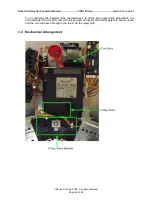
Bulk Coin Recycler Technical Manual
TSP157.doc
Issue 1.3
– Jan 11
Money Controls 2008. All rights reserved.
Page 9 of 45
2.6 Installation and Removal
Warning: Ensure that the power has been disconnected from the hopper before removal.
2.6.1
DISMANTLING THE HOPPER
Gently pull out the securing clips on the back of the base.
Tilt the bowl forward until it is clear of the clips.
Slide the bowl forward until the locating lugs are clear of the slots in the base.
Remove the motor assembly from the base and disconnect the cable.
2.6.2
HOPPER ASSEMBLY
Connect the cable to the motor assembly.
Lower the motor assembly into the base, ensuring the coin exit is in the desired
position.
Locate the lugs at the front of the bowl into the slots at the front of the base.
Gently press down on the top of the bowl until the securing clips (on the base) click
into the slots on the bowl.
2.7 Why Serial?
Coin hoppers traditionally have a simple parallel interface. Common methods for paying out
coins include ‘logic motor control’ whereby a low voltage control signal can be used to turn the
motor on an
d off, and ‘pulse counting’ whereby a stream of pulses is used to dispense the coins
(one coin per pulse). In the ‘logic motor control’ method it is up to the host software to monitor
and count coins travelling past the payout optos.
A be
nefit of ‘multi-drop’ serial is the ability to connect several coin hoppers to the same wiring
harness or ‘bus’. This greatly simplifies the cabling within a machine as multiple hoppers can be
daisy-chained together rather than having to branch out from a central star point. The number of
control signals is usually much less with serial than with parallel. The only control signal in the
ccTalk
protocol is a single bi-
directional ‘data’ line. It is also possible with serial to connect in
other money transaction peripherals such as coin acceptors, bill validators and card readers.
The inherent ‘expandability’ of serial allows for a much better level of diagnostics and error
reporting than is available on parallel, if it is available at all. Rather than a general alarm
condition, the difference between a coin jam and a deliberate attempt to fraud the hopper can
be reported externally.
2.8 Product Features
SCH2 represents to date the most sophisticated serial coin hopper in the world.
The following features are available on SCH2
…
Payout modes. The hopper defaults to multi-coin payout mode which pays up to 255
coins in a single dispense command.
Opto security. During idling (no coins being paid out), the exit optos are randomly pulsed.
If a blockage is seen while driving the opto or a short-circuit seen while not driving the
Summary of Contents for TSP157
Page 44: ......

































